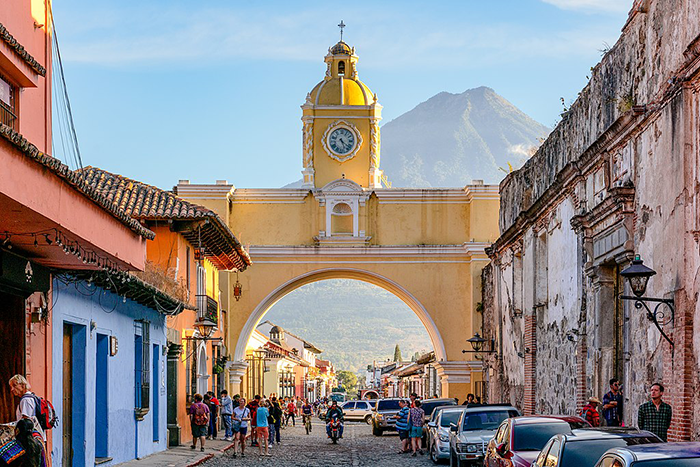
Hispanic Heritage Month is particularly important for me this year as I feel more connected to my Hispanic/Latino identity than I have in the past. Why?
Not because I am finally able to respond fluently in Spanish when people ask me questions in a language I am "supposed to know" (trust me, I am trying to learn). Not because I discovered more about my biological family in Guatemala who helped me come to this country and join a family that I am forever grateful for. And not because I feel the need to prove my heritage to anybody. Not for any other reason than my own recent and personal exploration of what it means to be a Jewish, Hispanic, Latino American in the 21st century.
Originally named National Hispanic Heritage Week starting in 1968, the U.S. dedicates a time of the year to celebrate the contributions of the Hispanic population to this country by citing specific events and figures, and highlighting a community that is often overlooked by non-Hispanic, white America. Lyndon B. Johnson signed National Hispanic Heritage Week into law, and 20 years later, President Ronald W. Reagan signed Hispanic Heritage Month into law. Contrary to the belief of some that immigrants are a danger to our society, former Michigan representative, Dale Kildee, more accurately identifies the pivotal role the Hispanic population has played in this country, and the importance of "commemorating the growth of our Nation's culture, vastly broadened and enriched by its Hispanic citizens." According to the 2020 U.S. Census Bureau, there are about 62.1 million Hispanics in the U.S., a population that continues to grow and furthers the advancement of this country.
Hispanic Heritage Month begins on the 15th of September and lasts until the 15th of October. The starting date was chosen to recognize a number of holidays and the independence of many Latin American countries from Spain, including Costa Rica, El Salvador, Honduras, Nicaragua, and Guatemala - my home country. The following day is the anniversary of Mexico's independence, the 18th celebrates Chile's independence, and the 21st marks Belize's independence from Great Britain. The month also includes Virgin Islands-Puerto Rico Friendship Day on October 10th, and Indigenous People's Day on October 12th, a date which recognizes a number of different holidays throughout Latin America such as Día de la Hispanidad and Día de la Raza.
Like many Latin American countries, the United States has a long history with Guatemala, first recognizing the country's independence in 1844. Immigration from Guatemala to the states has increased as the country continues to struggle with concerns of safety and independence. As of 2017, there are 1.4 million Guatemalan people in the U.S., they make up about 2% of the Hispanic population in this country.
Guatemalan people represent a blend of both Spanish and Mayan cultures as a result of Spain's colonization of the country, which further "complicates" my identity classification, as many Guatemalans are descendants of indigenous people. Our cuisine largely includes corn, chilies, beans, and meat. Our national instrument is a marimba, which I was unaware of at the time I joined the marimba elective at the Jewish Day School of Metropolitan Seattle (JDS) when I was in middle school.
Guatemalans are also known for our traditional Mayan textiles and outfits, particularly those worn by women, which are vibrant and colorful. Like in Judaism, there are specific handmade fabrics that are worn during important celebrations and religious holidays. For example, the Nim Po't or "big blouse" that women wear at weddings, or the huipil, a garment which communicates information about a weaver's birthplace, religion, and personality through their design and technique - a code that can be read by fellow weavers with a mere glance. My parents ordered me a tallit and a matching kippah for my bar mitzvah that were made by indigenous artists in Guatemala, and I wear them proudly to this day.
Guatemalan and Jewish cultures share the value of family, giving great importance to time spent around loved ones. It is not uncommon for people who live in rural areas of Guatemala to drop by unannounced. With the size of the country and its cities, it is easy to do so. And a practice often found amongst families in parts of Asia, the Middle East, Africa, Tribal lands, and Hispanic and Latinx/e communities, extended families in Guatemala often share one home. I hope to visit Guatemala in the near future, including the small city of Mixco where I was born. Until then, I hope to learn more about my heritage, and perhaps this Hispanic Heritage Month is the perfect time to do so.
"The National Council of Hispanic Employment Program Managers (NCHEPM), announced the 2022 Hispanic Heritage Month observance theme: 'Unidos: Inclusivity for a Stronger Nation.' The theme encourages us to ensure that all voices are represented and welcomed to help build stronger communities and a stronger nation."
As a Jewish Hispanic, Latino American, I hope to see more of us with intersectional identities highlighted within the Reform Movement and Jewish community as a whole. For now, I'll do my best to participate in the "call on citizens of this nation from all walks of life to look around and welcome new voices to the table."
Related Posts

Hispanic Heritage Month Ends, but the Recognition Must Continue

Reflections on Observing Black History Month in the Wake of the Capitol Insurrection


